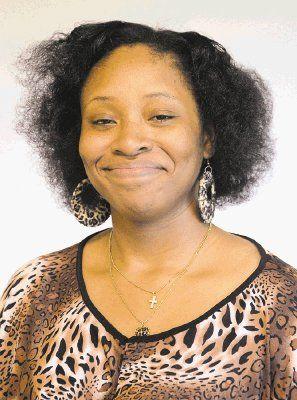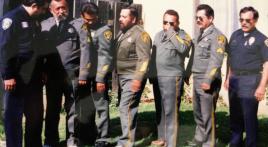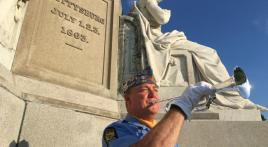Posted: Sunday, September 7, 2014 4:00 am | Updated: 8:07 am, Sun Sep 7, 2014.
By Alex Byrd abyrd@news-fjournal.com
When Meshell Horton was serving in the U.S. Army, she said she experienced something that today she can’t speak about.
“We are told that we can’t talk about certain things, but just know it was something bad that happened,” said Horton, 29, of Longview.
The memory of that experience lingers with the Army specialist, who was diagnosed with post-traumatic stress disorder.
The severity spectrum of mental health symptoms varies, but Horton said she hopes to put a human face on PTSD.
According to the National Institute of Mental Health, about one in 30 adults in the U.S. suffer from PTSD in a given year, with the risk being higher for war veterans.
New types of treatment are emerging for those with PTSD and traumatic brain injuries, such as hyperbaric oxygen therapy, and earlier this summer, the Rusk County Commissioners Court adopted a resolution advocating for those alternative types of treatment.
The written resolution “urges the Texas State Government to provide appropriate funding and focus” in terms of the “residual aftereffects of TBI and PTSD.”
Advocate Rainey Owen of Lexington, Republican Oklahoma state Rep. John Bennet and other lawmakers have been working to advocate for the alternative treatments.
“Success would be for them to recognize that it has a nearly 100 percent success rate among TBI, PTSD, the bends, neurological and skeletal injuries,” Bennett said.
Alternate treatments
Owen wrote an email to various Texas government officials advocating for hyperbaric oxygen therapy. His grandson is diagnosed with PTSD.
“He was effectively non-functional as a result. He was fortunate to receive treatment at Oklahoma State University using hyperbaric oxygen therapy,” Owen said.
The National Institutes of Health describes hyperbaric oxygen chambers as having two-and-a-half-times more pressure than in the atmosphere, which helps blood cells carry more oxygen.
“This therapy gave my grandson his life back, and he is now fully functional and repaired,” Owen said.
According to the U.S. Department of Public Affairs, about 20 percent of veterans, including those who served in Afghanistan and Iraq as well as the Gulf and Vietnam wars, are diagnosed with PTSD.
Those with PTSD face challenges from the public’s perception of those with a brain injury.
“Someone dealing with PTSD must deal with civilian life, relationships and a normal life,” said Matt Rifley, a military recruiter and real estate agent in Austin.
Those with PTSD can face a mental trigger at any time. Rifley recalled a friend visiting him in Longview four or five years after returning from Iraq. He said two boxcars loudly linked up at a railroad station, and it reminded the solider of an improvised explosive device, which is commonly found in war areas.
“Everyone has a different experience, not just from combat, but I know people that have Post Traumatic Stress Disorder from emotionally or physically abusive relationships,” Rifley said.
Problem solving
Bennett, the Oklahoma lawmaker, was first diagnosed with a traumatic brain injury in 2005.
After experiencing an intense migraine at a conference, Bennett underwent his first hyperbaric oxygen therapy experience in Tulsa, Oklahoma.
“The VA is trying hard, but they are spending millions on medicine and acupuncture that only works cognitively,” Bennett said.
According to Owen, about 43 Texas counties have approved resolutions similar to the ones approves in Rusk County advocating for treatment beyond prescribed pills.
“There’s no approved treatment for TBI or any any medication, so they use off-label drugs by the VA,” Owen said.
In June, Oklahoma became the first state to create a state fund for hyperbaric treatments.
This treatment and others could be paid for and made available for Oklahoma residents that are suffering from TBI and PTSD.
“I had a TBI injury that completely turned my life, around and we need the FDA to approve this — even if we only help one out one of 100 people,” Bennett said.
Horton served in the Army for 11 years, three of which were on active duty in Iraq. She now helps veterans with job placement at the Texas Workforce Commission in Longview.
“We need a group of veterans all on the same page to stick to the now instead of reveling in the past,” she said.
Horton, who was diagnosed with PTSD in 2009, said when she returned home from the Army, she was greeted by a veteran advocacy organization with smiles, but she admits that everyone does not have that luxury.
“I had support from my mom and others when I returned, but somehow it took me a year to seek help,” Horton said. “I was in my own little world.”
She said the biggest difficulty in seeking help is there is a public perception of being a military “cry baby.”
“But something’s gotta give, because I’m wearing heavy gear, while trying to suck it up during mood swings,” Horton said of her mental state.
Rifley said the best way to help people understand what veterans go through is to use “domestic violence or abuse as the best civilian equivalent.”
“PTSD affects people on every level,” Rifley said. “After serving, they never see life quite the same way and sometimes it’s more amplified.”
Agency assists homeless veterans
Lenda Jones hugs her daughter U.S. National Guard Specialist, Meshell Horton on Thursday in front of her Longview home. Jones has moved in with Horton to help her with bills after Horton was diagnosed with PTSD and multiple sclerosis and learned that her disability pay was not sufficient.
Posted: Monday, July 22, 2013 4:00 am | Updated: 12:21 pm, Mon Jul 22, 2013.
By Sarah Thomas sthomas@news-journal.com
Of the 1.6 million U.S. military veterans living in Texas, on any given night between Longview and Texarkana several hundred are believed to be sleeping on the ground, in a tent, a room someone gave them or in a homeless shelter.
The U.S. Department of Veterans Affairs this past week announced nearly $300 million in grants to help the nation’s approximate 120,000 homeless and at-risk veterans and their families.
Community Healthcore in Longview announced receipt of a $211,000 grant from the Texas Veterans Commission to deal with the issue — $30,000 of which is strictly to fund the Veteran & Family Housing Program.
“The reality is that there are no services here in East Texas that a veteran can go to get some help,” said Dwayne Bennett, community development specialist for Community Healthcore. “You’ve got veterans and veterans services scattered all over the country, but those services don’t reach rural areas.
The grant, good for one year, will provide support for veterans and their families, including helping them obtain or keep housing, military benefits, employment, education and medical care and financial help with utilities.
Bennett said housing issues sometimes stem from landlords who aren’t “vet friendly.”
“Some people shy away from renting to veterans because they fear they have issues (such as Post Traumatic Stress Disorder and substance abuse),” Bennett said.
A lack of skills that can be transferred to civilian jobs compounds the problem, leaving many veterans at a disadvantage in the job market.
Bennett said some issues are compounded because some veterans are afraid they will be perceived as weak if they ask for help.
“They’re too proud to seek out treatment, but they will go to a place where there are other veterans they can talk to, veterans who are trained peer counselors,” Bennett said.
U.S. Department of Housing and Urban Development estimates more than 62,000 veterans are homeless on any given night. Annual homeless counts completed in Texarkana and Longview indicate there are several hundred homeless veterans on any given night across Northeast Texas, according to data released by Community Healthcore.
The program will be available to any veteran living in the nine counties served by Community Healthcore, including Gregg, Harrison, Rusk, Upshur, Panola, Marion, Bowie, Cass and Red River counties.
Harrison Kinney, director of strategic initiatives for Community Healthcore, said the program was born of a need for veterans to talk to other veterans, adding people open up more when they know the person they’re talking to has walked in their shoes.
“This is about the vets, for the vets and by the vets,” he said.
The new East Texas Veteran Resource Center will be located in three suites at Community Connections, 501 Pine Tree Road which, Community Healthcore officials hope to transform into a hub for all veteran-related services.
The center will be staffed mostly by veterans like U.S. National Guard Specialist. Meshell Horton.
Horton knows firsthand the struggles veterans face. She was 21 when she was first deployed to Iraq.
In January 2011, while receiving help for PTSD, Horton was diagnosed with multiple sclerosis.
She receives 80 percent disability and has applied for full disability.
“My mother lives with me to help because my disability only covers my car note, mortgage and insurance,” Horton said.
Horton is in the process of being medically chaptered, or retired, from the Army.
Until then, she remains on orders with the National Guard and drills in Marshall.
Horton believes the new program will be a Godsend because most veterans are afraid of being judged by people who have never been where they are.
“You don’t want to be labeled as damaged goods,” Bennett said.
“Yeah, that’s what I felt like, damaged goods,” Horton added.
Marine Corp veteran Tracy Sepulvado said it is not uncommon for some veterans to experience feelings of worthlessness.
“The veteran, the way he sees his tour of duty is like this: If you receive the Purple Heart for being wounded, it is an honor. But if you are disabled it’s a disgrace,” he said.
Although the grant will provide much-needed support, Kinney said, donations will be needed to reach every vet in need of housing.
“As with most of our programs, there are always more people asking for help than what is available,” Bennett added.
He said his group recognizes all veterans, not just those who served on foreign soil, which is how the U.S. Department of Veterans Affairs defines a veteran.
The East Texas Veterans Resource Center also will operate on an outreach basis if a veteran can’t come to the center.
Bennett hopes area doctors and judges will begin to understand they can refer patients to the center.
“We just want to say welcome home and we want to go shoulder to shoulder with you,” he said. “No one will judge you. There’s going to be someone to look you in the eye, someone who has been there.”




